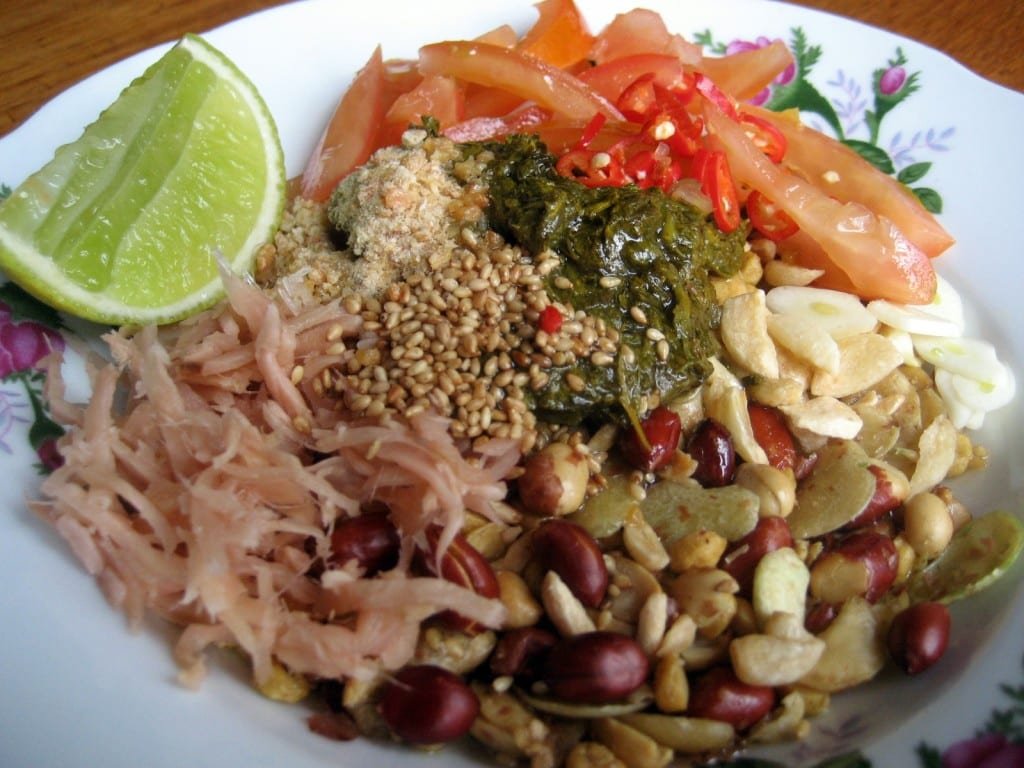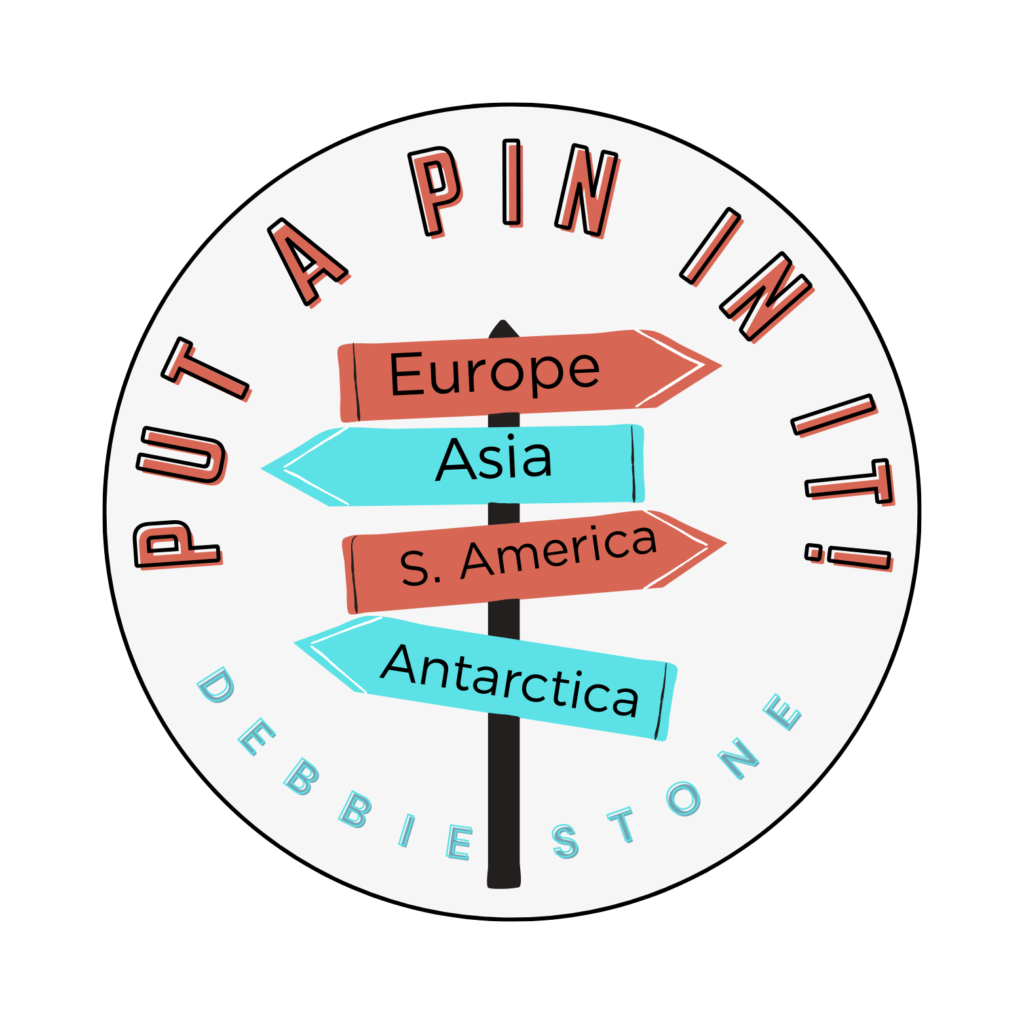Myanmar cuisine is a confluence of many aspects of the country. Myanmar’s geographic location, with China, India, and Thailand as neighbors, its many ethnic minorities, and the principles of Buddhism all contribute to its diverse assortment of dishes.
Fish products like fish sauce and ngapi, a paste made of fermented seafood, are used extensively in Burmese dishes. And because of Myanmar’s proximity to the sea, many of the coastal cities like Mawlamyaing, Mergui, and Sittwe, have also produced dishes where fish and shrimp are the primary sources of protein.
Traditionally, meals are served all at once, with the dishes all laid out for the diners to choose. White rice or htamin is usually the main dish and the side dishes are called hin.
There are no appetizers, wine, or spirits served at the meal. In fact, drinks in general are not served with the meal and the liquid aspect of the meal comes from the soups in the meal itself. When the meal is served, people take small portions of whatever dishes they like and normally use their fingers, although forks and spoons have become popular.
In terms of serving order, the elderly and guests are given the first turn by letting them take some curry first. At the end of the meal, desserts such as laphet, fruit, or jiggery may be served with water, green tea, or juice.
Main Dishes
Main dishes can include meat or fish, vegetables or salads, or soup. Meat dishes include chicken, duck, pork, or mutton, but beef is not usually served.
Curry: Usually tomato or coconut based with a layer of oil on top and rarely chili hot.
Kat Kyi Hnyat: Rice noodles with seafood, meats, raw bean sprouts, beans and fried eggs; similar to Pad Thai, it is a Southern coastal dish from the Dawei area.
Htamin jaw: Fried rice with boiled peas.
Danbauk: Burmese style biryani with chicken or mutton served with pickled mango, fresh mint, and green chili.
Htamin jin (Gyin): Fresh or fermented rice, kneaded with boiled fish, fresh tomato paste, mashed boiled potatoes, and garlic garnish; a dish of the Intha people of Inle Lake.
Soups
Soups are usually regarded as an indispensable part of a meal, because traditionally the Burmese do not drink anything, even water, during the meal. However, if soup is not available, green tea is served instead. There are four main types of soups: sweet, hot and spicy, sour, and bean. Spicy soups can also be used to stimulate the appetite of the diners.
Kyay Oh: Soup served with meatballs and noodles.
Schwe Payon Hinjo: Pumpkin soup with garlic, chicken stock, salt and peanut oil.
Chicken San Pyoke: Rice soup with chicken, garlic and onions.
Salads (Thoke)
Salads in Burmese cuisine are different from the Western style of salad. Myanmar salads are a hand mixed combination of raw, boiled, or preserved ingredients, with onion, tamarind juice, chili powder, fish sauce, fried shredded garlic and pounded dried shrimp.
Gyin Thoke: Ginger salad with sesame seeds.
Nangyi Thoke: Thick rice noodles mixed with a specific kind of chicken curry, often garnished with chickpea flour, sliced onions, chilies, crispy noodles and hard-boiled egg, and zested with lime or lemon.
Samusa Thoke: Samosa salad with onions, cabbage, fresh mint, potato curry, masala, chili powder, salt and lime.
Thinbaw thi thoke: Papaya salad mixed with ground dried shrimp, onions, and fried garlic; similar to Thai Som tam.
Snacks
The idea of a “snack” in Myanmar is a little different from the concept in the Western world, since many Burmese snacks could be considered a small meal. Many Burmese snacks are made of rice or glutinous (sticky) rice, milk or grated shards of coconut, and sugar or jaggery as sweeteners. Snacks are eaten at breakfast, randomly throughout the day, or at tea times.
Mohinga: Fish noodle soup. It’s a popular breakfast dish, although sold all day long.
Laphet Thote (Thohk): A pickled tea leaf salad served with sesame seeds, fried garlic and roasted peanuts. Depending on the restaurant you eat at, the sesame seeds, garlic and peanuts may be mixed with the tea leaves beforehand or arranged separately around a plate.
Ohnnoh Khauk Swe: Wheat noodles in a curried chicken and coconut milk soup; closely related to laksa from Malaysia, khao soi of Thailand and Laos, and khow suey of India.
Samusas (Samosas): Influenced by Indian samosas, Burmese samosas (sometimes spelled samusas) are filled with mutton and onions served with fresh mint, green chili, onions and lime or lemon
Hnyin Htoe (Hinto): Popular in the Shan State, influenced by its Chinese neighbor, it’s a steamed wrapped banana leaf filled with onion, rice, cabbage, and leek.
San byohk: Rice congee with fish, chicken, or duck.
Chapti: Burmese style flatbread, fried, with boiled peas
Halawa: Made of glutinous rice, butter, coconut milk; consistency is like a smashed potato; similar to the Indian halwa.
Meeshay: Rice noodles mixed with meat sauce made of pork and/or chicken; there are two popular variants: Shan/Mogok Meeshay and Mandalay Meeshay; specialty of the Shan people in Eastern Myanmar.
Htamane: Glutinous rice, shredded coconuts and peanuts.
Mont Di: A “fast food” dish; Rice vermicelli (thin rice noodles) are eaten with soup or salad.
Desserts
A dessert course is not typically served when at home, but it’s customary when entertaining guests or at charity feasts. Laphet (see Snacks section) can be served as a dessert as well.
Kyauk Kyaw: Seaweed jelly with a coconut milk layer on top
Thagu or Thagu Byin: Sago or tapioca pudding sweetened with jaggery and coconut
Jaggery: Uncentrifuged sugar– harvested from toddy palm syrup. It’s the only dessert popular with rural families in Upper Myanmar.
If you would like to submit a guest post on food, wine or travel to Where and What in the World, I would be happy to feature your travel experience , drink, special wine tasting, or family or simply delicious recipe. If you go to submission tab, you will see how to submit, as well as have the opportunity of telling me if you would like to would like to be a regular contributor. When uploading a file for submission, you are also able to upload jpgs. Please feel free to put a last paragraph about you and a link to your profile. No html please. You can also include a head shot.















